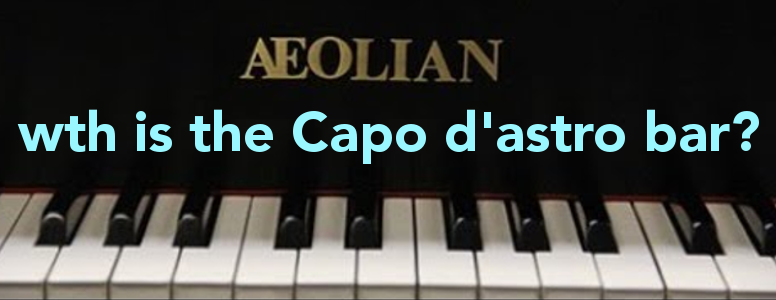Don’t stop me if you’ve heard this before.
The story of the Capo ‘d astro bar is not new, but the point of the story continues to be forgotten, even by the best creative marketers.
First, the story, straight from Bud Robbins, goes like this:
“Looking for the Capo d’astro bar.”
By Bud Robbins
Back in the sixties, I was hired by an ad agency to write copy on the Aeolian Piano Company account. My first assignment was for an ad to be placed in The New York Times for one of their grand pianos. The only background information I received was some previous ads and a few faded close-up shots…and of course, the due date.
The Account Executive was slightly put out by my request for additional information and his response to my suggestion that I sit down with the client was, ‘Don’t tell me you’re one of those? Can’t you just create something? We’re up against a closing date!’
I acknowledged his perception that I was one of those, which got us an immediate audience with the head of our agency.
I volunteered I couldn’t even play a piano let alone write about why anyone would spend $5,000 for this piano when they could purchase a Baldwin or Steinway for the same amount.
Both allowed the fact they would gladly resign the Aeolian business for either of the others; however, while waiting for the call, suppose we make our deadline.
I persisted and reluctantly, a tour of the Aeolian factory in Upstate New York was arranged. I was assured that ‘we don’t do this with all our clients’ and my knowledge as to the value of company time was greatly reinforced.
The tour lasted two days and although the care and construction appeared meticulous, $5,000 still seemed to be a lot of money.
Just before leaving, I was escorted into the showroom by the National Sales Manager. In an elegant setting sat their piano alongside the comparably priced Steinway and Baldwin.
‘They sure look alike,’ I commented.
‘They sure do. About the only real difference is the shipping weight—our is heavier.’
‘Heavier?’ I asked. ‘What makes ours heavier?’
‘The Capo d’astro bar.’
‘What’s a Capo d’astro bar?’
‘Here, I’ll show you. Get down on your knees.’
Once under the piano, he pointed to a metallic bar fixed across the harp and bearing down on the highest octaves. ‘It takes 50 years before the harp in the piano warps. That’s when the Cap d’astro bar goes to work. It prevents warping.’
I left the National Sales Manager under his piano and dove under the Baldwin to find a Tinkertoy Capo d’astro bar at best. Same with the Steinway.
‘You mean the Capo d’astro bar really doesn’t go to work for 50 years?’ I asked.
‘Well, there’s got to be some reason why the Met uses it,’ he casually added.
I froze. ‘Are you telling me that the Metropolitan Opera House in New York City uses this piano?’
‘Sure. And their Capo d’astro bar should be working by now.’
Upstate New York looks nothing like the front of the Metropolitan Opera House where I met the legendary Carmen, Rise Stevens. She was now in charge of moving the Metropolitan Opera House to the Lincoln Center.
Ms. Stevens told me, ‘About the only thing the Met is taking with them is their piano.’
That quote was the headline of our first ad. And the result created a six-year wait between order and delivery.
So now you know the story of the Capo d’atro bar, a memorable tale of how and why the search for a key advantage is required to help a brand or product stand out in the minds of would-be customers.
There have been many versions of this approach, the competitive advantage, the preeminent benefit, the point of differentiation, or most famous might be the USP or Unique Selling Proposition.
Whatever it is called, the job of finding the unique, meaningful, valuable-to-the-user benefit is a critical task. One that most agencies and marketing executives don’t give adequate importance.
I like to frame it more from the customer’s perspective than from the product’s. Because of this, I like the idea of the benefit aligning with Deep Meaningful Value to the customer – so I call it the products DMV.
Once the DMV is defined, then it’s a joy to enter the creative ideation stages to come up with the best way to dramatize and make the the DMV memorable in context of the product and brand. But let’s be clear, that’s the easy part.
Every brand or product has a Capo d’astro bar of it’s own. It’s our job to find it and then connect it to the deep meaningful value (DMV) that will surprise and delight our ideal prospects as they journey along the customer path.
Kent Land is a marketing and communications strategist, creative director, social entrepreneur and musician who can be found at brand67.com. Read other marketing and creative articles at Brand67 or you can email kent@brand67.com
#capodastrobar #dmv #deepmeaningfulvalue #uniquesellingproposition #emotionalbranding #brandinginsights #branding #brandinsights #brandstrategy #brandmarketing #marketingideas #brandinnovation

